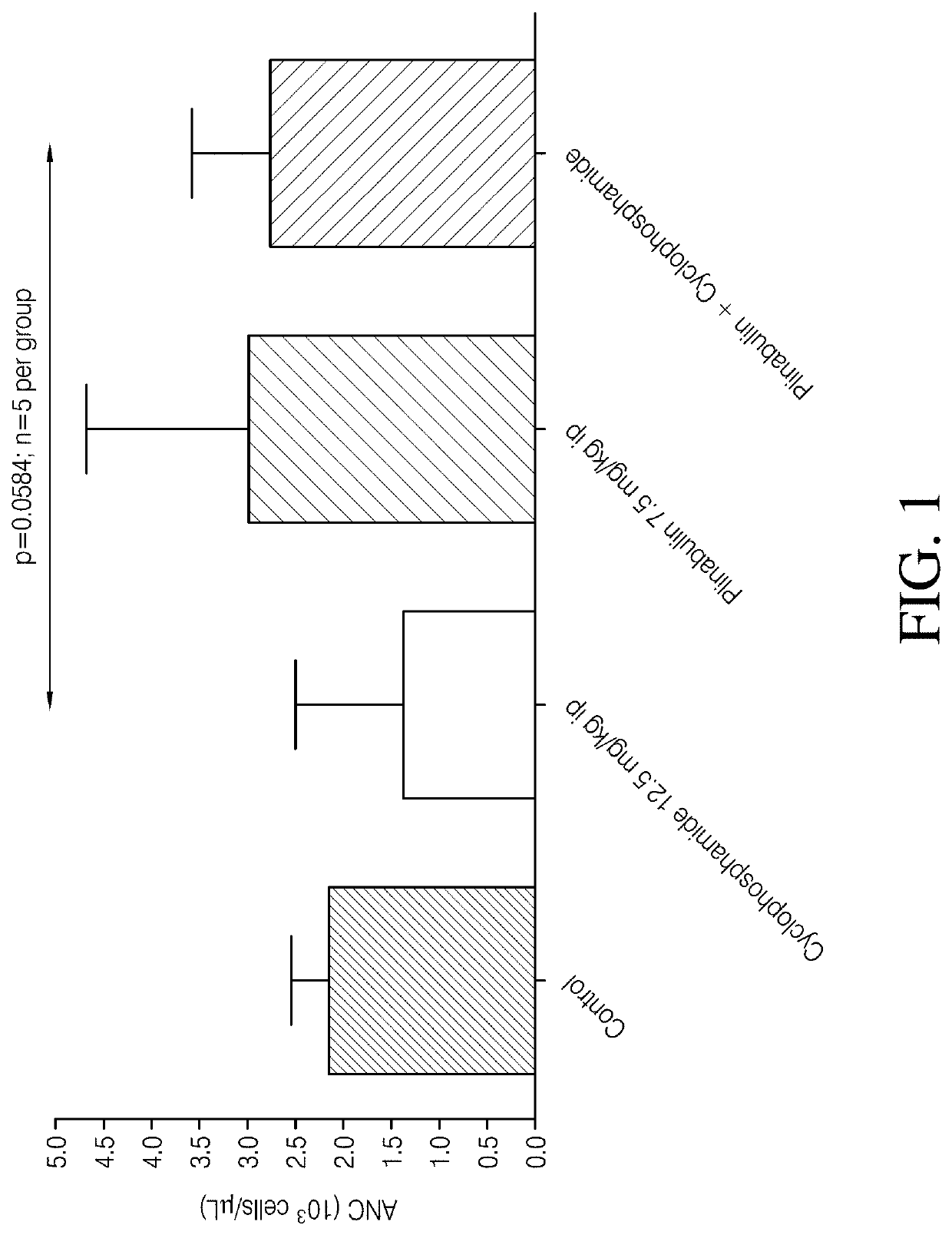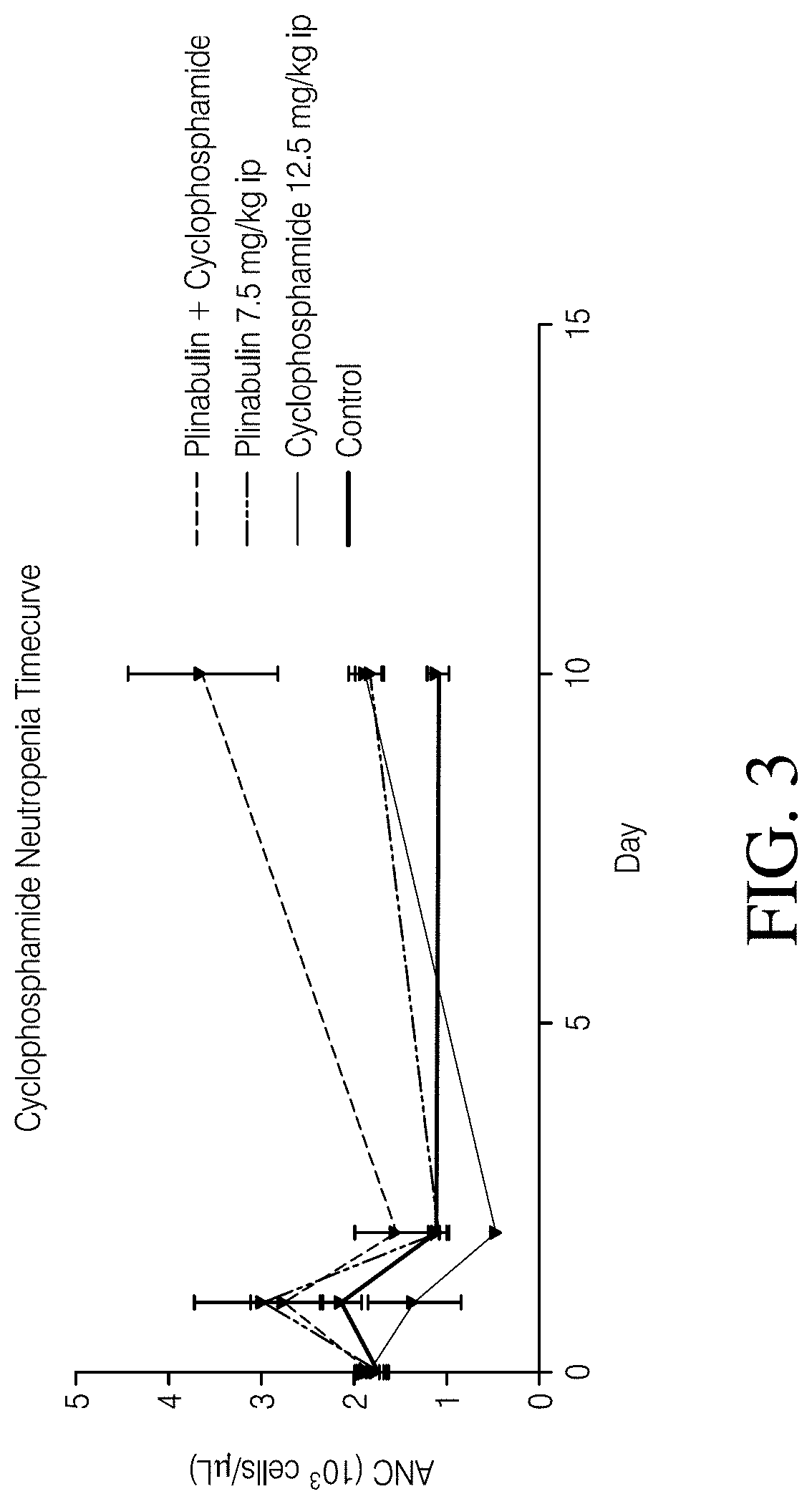Composition and method for reducing neutropenia
a neutropenia and composition technology, applied in the field of chemistry and medicine, can solve the problems of radiation therapy being a cause of neutropenia, cancer therapies can have deleterious side effects, etc., and achieve the effect of reducing neutropenia
- Summary
- Abstract
- Description
- Claims
- Application Information
AI Technical Summary
Benefits of technology
Problems solved by technology
Method used
Image
Examples
example 1
[0111]The effect of plinabulin alone, cyclophosphamide alone, and the combination of plinabulin and cyclophosphamide on neutropenia was evaluated in male Sprague-Dawley rats. Fifteen rats each were placed in 4 treatment groups according to Table 1. The indicated doses were administered through intraperitoneal injection on Day 1 with Administration 2 being given 1 hour following Administration 1.
TABLE 1Treatment GroupsGroup No.TreatmentAdministration 1Administration 21Naïve control——2Vehicle +VehiclePlinabulinPlinabulin10 ml / kg7.5 mg / kg(7.5 ml / kg)3Cyclophos-Cyclophos-Vehiclephamide +phamide7.5 ml / kgVehicle12.5 mg / kg(10 ml / kg)4Cyclophos-Cyclophos-Plinabulinphamide +phamide7.5 mg / kgPlinabulin12.5 mg / kg(7.5 ml / kg)(10 ml / kg)
[0112]For treatment groups that included administration of a vehicle, the vehicle consisted of 7.11% Tween 80 (v / v): 25.5% Propylene glycol (v / v): 67.4% D5W (v / v). D5W is 5% dextrose in water for injection. For groups that included administration of plinabulin, plinab...
example 2
[0119]A study was performed to evaluate the effect of Plinabulin in reducing or treating neutropenia induced by chemotherapeutic agents such as cyclophaphamide. Male Sprague-Dawley rats were first treated with cyclophosphamide, or vehicle saline (control). The control sample contained 7.1% Tween 80 (v / v), 25.5% Propylene glycol (v / v), and 67.4% D5W(5% dextrose in water) (v / v). One hour later, the rats were dosed with Plinabulin or its vehicle following the administration schedule shown in Table 2. Each test group included 15 rats.
TABLE 2Treatment GroupsGroup No.TreatmentAdministration 1Administration 21Naïve control——2Cyclophos-Cyclophos-Vehiclephamide +phamide7.5 ml / kg,Vehicle12.5 mg / kg,(10 ml / kg)3Cyclophos-Cyclophos-Plinabulinphamide +phamide7.5 mg / kgPlinabulin12.5 mg / kg,(7.5 ml / kg)(10 ml / kg)4Vehicle +VehiclePlinabulinPlinabulin(10 ml / kg)7.5 mg / kg(7.5 ml / kg)
[0120]Blood collection was performed for absolute neutrophil counts in blood samples collected at Day −1 (pre-dose), Day 2 (2...
example 3
[0123]A study was performed to evaluate the effect of plinabulin in reducing or treating doxorubicin induced neutropenia. Male Sprague-Dawley rats were first treated with doxorubicin or vehicle saline (control). The control sample included 7.1% Tween 80 (v / v), 25.5% Propylene glycol (v / v), 67.4% D5W (v / v). One hour later, the rats were dosed with Plinabulin or its vehicle following the administration schedule shown in Table 7. Each test group included 6 rats. The doxorubicin was administered intravenously, and plinabulin was administered through intraperitoneal injection.
TABLE 7Treatment groupsDoxorubicinPlinabulinGroupTreatmentDose (mg / kg)Dose (mg / kg)ANaïve Control——BDoxorubicin + Vehicle30CPlinabulin—7.5DDoxorubicin + Plinabulin31.75EDoxorubicin + Plinabulin33.5FDoxorubicin + Plinabulin37.5
[0124]Blood collection was performed for ANC in blood samples collected at Day −1 (pre-dose), Day 2, Day 3, Day 4, Day 5 and Day 8 post single dosing with control, doxorubicin at Day 1 followed ...
PUM
 Login to View More
Login to View More Abstract
Description
Claims
Application Information
 Login to View More
Login to View More - R&D
- Intellectual Property
- Life Sciences
- Materials
- Tech Scout
- Unparalleled Data Quality
- Higher Quality Content
- 60% Fewer Hallucinations
Browse by: Latest US Patents, China's latest patents, Technical Efficacy Thesaurus, Application Domain, Technology Topic, Popular Technical Reports.
© 2025 PatSnap. All rights reserved.Legal|Privacy policy|Modern Slavery Act Transparency Statement|Sitemap|About US| Contact US: help@patsnap.com



